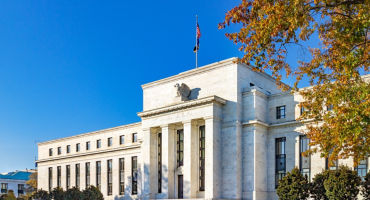- Fixed Income Analyst
Skip to main content
- Funds
- Insights
- Capabilities
- About Us
- My Account
The views expressed are those of the author at the time of writing. Other teams may hold different views and make different investment decisions. The value of your investment may become worth more or less than at the time of original investment. While any third-party data used is considered reliable, its accuracy is not guaranteed. For professional, institutional, or accredited investors only.
As widely expected, the Federal Open Market Committee (FOMC) raised the target federal funds rate by 25 basis points (bps), to a range of 4.50% to 4.75%, at its February meeting. The FOMC made no changes to its plans regarding the ongoing reduction of its balance sheet, which began in June 2022.
In the FOMC’s statement, the Committee noted that inflation “has eased somewhat but remains elevated” and echoed its previous assessment that “ongoing increases” to the target rate will likely be appropriate.
During the post-meeting press conference, US Federal Reserve (Fed) Chair Jerome Powell enthusiastically noted that disinflation has begun without moderation in labor market strength. He expressed optimism that disinflation may continue without a material increase in unemployment or a substantial slowing in growth. Chair Powell dismissed concerns about divergence between the Committee’s forecasts for interest rates and futures market pricing, suggesting that the difference was due to alternative outlooks on the pace of disinflation. He also allowed for the possibility of decreases in the target range this year should inflation fall more quickly than the Committee thinks it will.
The US bond market interpreted Chair Powell’s remarks as quite dovish, pushing yields on short-dated Treasury securities lower.
The minutes of the December 2022 FOMC meeting suggested that the Committee was worried about loosening financial conditions, noting “an unwarranted easing in financial conditions, especially if driven by a misperception by the public of the Committee’s reaction function, would complicate the Committee’s effort to restore price stability.” By many metrics, financial conditions have indeed eased since December, and the decline in interest rates following the Fed’s press conference yesterday will likely contribute to further easing of financial conditions. However, Chair Powell essentially dismissed questions about such easing, instead focusing on the longer-term tightening of conditions over the last year. The question for markets, then, is whether easing is “warranted” given the actual data.
Since December, both inflation and wages have moderated and may continue to do so amid recent slowing in real growth indicators. The December CPI and core CPI prints were 6.5% and 5.7%, respectively. Both manufacturing and services ISM data have been below expectations. Additionally, consumer spending and retail sales have cooled. And importantly, average hourly earnings in December dipped to 4.6%, from 5.0%. Temporary employment, which is a useful leading indicator of labor market strength, has also declined.
Despite the slowing, we still see signs that the US economy could surprise to the upside, and should growth prove more robust than anticipated, the Fed may need to increase interest rates more than is currently priced into the futures market. Initial jobless claims have been below expectations every print since December’s FOMC meeting, while the unemployment rate has declined from 3.7% to 3.5%. Some growth numbers have also been better than expected, including fourth-quarter GDP (2.9%). Data related to the housing market and indicators of consumer sentiment have generally printed above consensus as well. Finally, the reopening of China’s economy appears to be proceeding apace, which may put upward pressure on global inflation and growth.
The FOMC is reinvesting Treasury and mortgage-backed securities (MBS) up to caps of $60 billion and $35 billion, respectively. There has been speculation that balance-sheet reduction may end earlier than previously anticipated due to declining bank reserves, which are important operationally to the Fed’s implementation of quantitative tightening. As of January 26, reserve balances with Fed banks were around $3 trillion, down from a peak of nearly $4.2 trillion in the third quarter of 2021. Likewise, take-up at the Fed’s overnight reverse repurchase facility has increased to over $2 trillion, after being used very little prior to the second quarter of 2021.
Chair Powell gave no indication yesterday that the Fed is concerned about reserve scarcity, leading me to believe the FOMC is unlikely to alter balance-sheet normalization in the near-term. This is particularly true with MBS running off the Fed’s balance sheet at a pace of about $20 billion a month since September 2022, well below the maximum implied by reinvestment caps. This may mean balance-sheet reduction has put less downward pressure on home prices and shelter costs than previously thought.
The ongoing normalization of the Fed’s balance sheet, which swelled during the height of the COVID crisis, is likely to progress as planned in the coming months, and the FOMC will probably continue hiking interest rates until it sees sustained evidence of disinflation, including decelerating inflation in the services sector. Although slowing inflation, labor market strength, and better-than-expected growth impulses are welcome, we believe it is possible that the market narrative has moved ahead of the actual data with regard to the hoped-for “soft landing” economic scenario. By its own admission, the FOMC still has some work to do to go to get inflation back down to the Fed’ target range — and if history is any guide, that’s going to be tough to pull off without tipping the US economy into some form of recession.
Expert

Chart in Focus: Is the Fed rate cut positive for risk?
Continue readingThe Fed architecture under scrutiny: What are the investment implications?
Continue readingTwilight zone: how to interpret today’s uncertain macro picture
Continue readingURL References
Related Insights
Stay up to date with the latest market insights and our point of view.

FOMC: Easing into uncertainty
Fixed Income Portfolio Manager Jeremy Forster profiles the Fed's December rate cut, labor market trends, inflation pressures, and the role of anticipated changes to FOMC leaders in 2026.

Chart in Focus: Is the Fed rate cut positive for risk?
In this edition of Chart in Focus, we examine how the Fed’s long-awaited interest rate cut may influence risk assets.

The Fed architecture under scrutiny: What are the investment implications?
Macro Strategist Juhi Dhawan looks at how changes in the Federal Reserve's personnel and decision making could impact policy, the US dollar, and financial markets.

FOMC: Cushioning the US labor market
Fixed Income Portfolio Manager Jeremy Forster analyzes the Fed's decision to cut interest rates at the September FOMC meeting.

Twilight zone: how to interpret today’s uncertain macro picture
Macro Strategist John Butler and Investment Director Marco Giordano explore how to interpret today’s uncertain macroeconomic picture and its key implications.

Rethinking the Fed’s dual mandate
Is it time for a fresh perspective on the dual mandate? Fixed Income Portfolio Manager Brij Khurana explores the potential benefits of reorienting monetary policy toward maximizing productivity.

Stagflation watch: Thoughts on tariffs, inflation, and Fed policy
US Macro Strategist Juhi Dhawan considers signs the US economy may be moving toward a toxic mix of slowing growth and rising inflation, creating challenges for the Fed and investors.

Severance: The split between the economy and the markets
While markets have bounced back since Liberation Day, policy changes and macro data bear watching. Heading into the second half of 2025, we're focused on relative opportunities across asset classes created by disconnects and divides between markets and economies.

Oh baby, baby, it’s a wild world
Just one quarter into the year, many policy and economic assumptions have been turned on their head. What does it all mean for equity, bond, and commodity markets around the world? Members of our Investment Strategy & Solutions Group offer their outlook.

Fed delivers rate cut, but hawkish 2025 guidance sends yields up
Fixed Income Analyst Caroline Casavant examines the outcome of the December 18 Federal Open Market Committee meeting and the implications for rates, inflation, and real growth.

Going their separate ways: Capitalizing on bond divergence
Our fixed income experts discuss how to position portfolios for a world of uncertainty and divergence, exploring key themes and evolving bond opportunities for 2025.
URL References
Related Insights